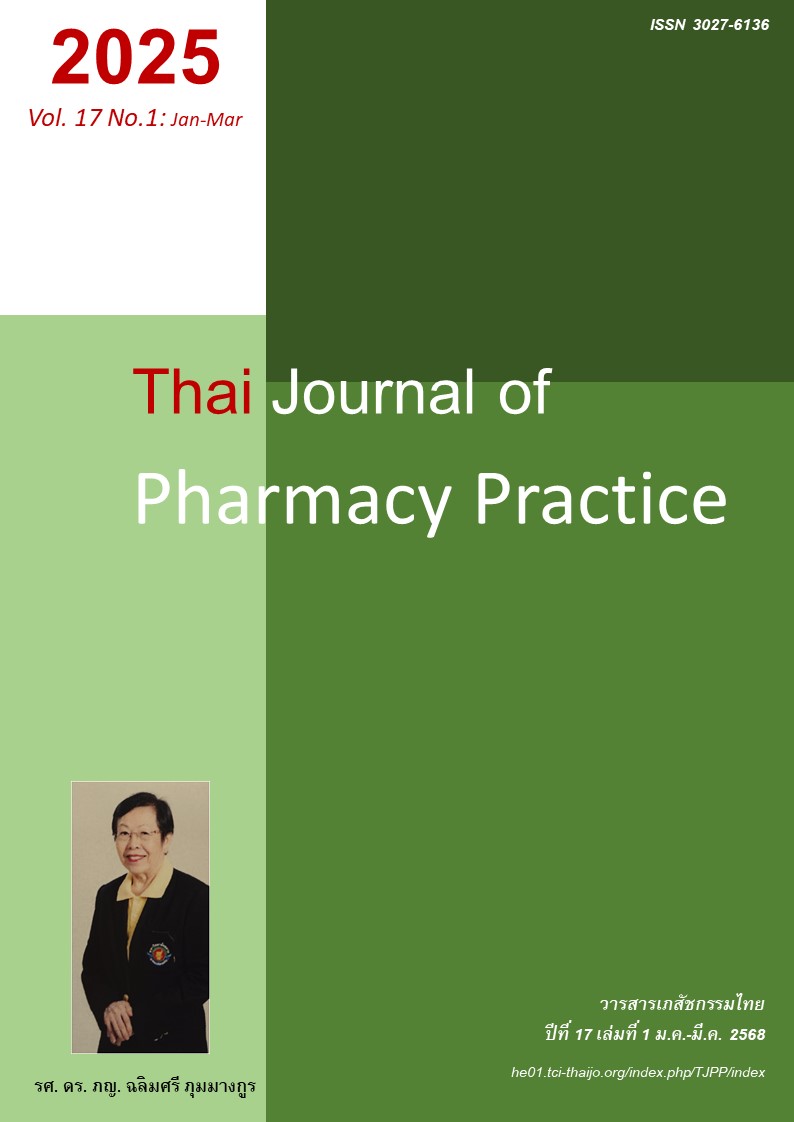ความชุกของการแสดงฉลากที่ไม่ถูกต้องและการปลอมปนสารห้ามใช้ของ เครื่องสำอางที่จดแจ้งด้วยระบบ E-submission ในจังหวัดเชียงใหม่
Main Article Content
บทคัดย่อ
วัตถุประสงค์ : เพื่อศึกษาความชุกของการแสดงฉลากที่ไม่ถูกต้อง และการปลอมปนสารห้ามใช้ในเครื่องสำอางที่จดแจ้งด้วยระบบ E-submission ในจังหวัดเขียงใหม่ วิธีการ: การวิจัยภาคตัดขวางครั้งนี้ศึกษาคำขอจดแจ้งเครื่องสำอางที่ให้ผู้ประกอบการถ่ายรูปฉลากเครื่องสำอาง พร้อมนำส่งผลิตภัณฑ์เพื่อตรวจสอบสารห้ามใช้ 4 ชนิดด้วยชุดทดสอบเบื้องต้น การศึกษาประเมินความรู้ของผู้ประกอบการเกี่ยวกับฉลากที่ถูกต้องและสารห้ามใช้โดยส่งแบบสอบถามในรูปแบบ Google Forms ผ่าน Line official ผลการวิจัย: จำนวนคำขอจดแจ้งเครื่องสำอางของจังหวัดเชียงใหม่ที่อนุมัติผ่านในระบบ E-submission ปีงบประมาณ 2565 ทั้งสิ้น 1,282 คำขอ แบ่งเป็นผลิตภัณฑ์ความเสี่ยงสูง 216 คำขอ (ร้อยละ 16.85) และความเสี่ยงต่ำ 1,066 คำขอ (ร้อยละ 83.15) การตรวจสอบฉลากเครื่องสำอาง 127 รายการพบฉลากไม่ถูกต้อง 97 รายการ (ร้อยละ 76.38) เครื่องสำอางประเภทขออนุญาตนำเข้ามีสัดส่วนของผลิตภัณฑ์ที่มีฉลากที่ไม่ถูกต้องมากกว่าเครื่องสำอางประเภทขออนุญาตผลิตอย่างมีนัยสำคัญทางสถิติ (ร้อยละ 100 และร้อยละ 73.45 ตามลำดับ P= 0.039) การตรวจสอบสารห้ามใช้ในเครื่องสำอาง 68 รายการ พบสารห้ามใช้ 9 รายการ (ร้อยละ 13.24) เครื่องสำอางที่พบสารไฮโดรควิโนน มีสัดส่วนของการแสดงฉลากไม่ถูกต้องน้อยกว่าเครื่องสำอางที่ไม่พบสารไฮโดรควิโนนอย่างมีนัยสำคัญทางสถิติ (ร้อยละ 33.33 และ ร้อยละ 75.80 ตามลำดับ, P= 0.047) การประเมินความรู้เกี่ยวกับการแสดงฉลากที่ถูกต้องและสารห้ามใช้ของผู้ประกอบการ 36 คน ได้คะแนนเฉลี่ย 13.81 ± 2.65 คะแนน (คะแนนเต็ม 20 คะแนน) สรุป: คำขอจดแจ้งเครื่องสำอางผ่านระบบ E-submission พบเครื่องสำอางประเภทความเสี่ยงต่ำมากกว่าความเสี่ยงสูง เครื่องสำอางประเภทนำเข้า และไม่มีสารไฮโดรควิโนนมีโอกาสพบฉลากที่ไม่ถูกต้องมากกว่า และอาจพบสารห้ามใช้ในผลิตภัณฑ์ที่ฉลากถูกต้องได้ ผลการศึกษาอาจใช้เป็นข้อมูลเบื้องต้นในการวางแผนการทำงานของเจ้าหน้าที่ในการเฝ้าระวัง ติดตามผลิตภัณฑ์เครื่องสำอางที่จดแจ้งผ่านระบบ E-submission เพื่อลดความเสี่ยงแก่ผู้บริโภคต่อไป
Article Details

อนุญาตภายใต้เงื่อนไข Creative Commons Attribution-NonCommercial-NoDerivatives 4.0 International License.
ผลการวิจัยและความคิดเห็นที่ปรากฏในบทความถือเป็นความคิดเห็นและอยู่ในความรับผิดชอบของผู้นิพนธ์ มิใช่ความเห็นหรือความรับผิดชอบของกองบรรณาธิการ หรือคณะเภสัชศาสตร์ มหาวิทยาลัยสงขลานครินทร์ ทั้งนี้ไม่รวมความผิดพลาดอันเกิดจากการพิมพ์ บทความที่ได้รับการเผยแพร่โดยวารสารเภสัชกรรมไทยถือเป็นสิทธิ์ของวารสารฯ
เอกสารอ้างอิง
Department of Business Development. Cosmetics business [online]. 2021 [cited Mar 30, 2023]. Availa- ble from: www.dbd.go.th/news.htm.
Cosmetic Act B.E. 2558. Royal Gazette No.132, Part 86A (Sep 8, 2015).
Public Health Ministerial Declaration in 2018 on cosmetic notification. Royal Gazette No.135, Part 208D special (Aug 29, 2018).
Food and Drug Administration. Cosmetic registration with automatic system that is convenient, easy and unlimited number of applications: an introduction [online]. 2017 [cited Mar 30, 2023]. Available from: www.privus.fda.moph.go.th.
Food and Drug Administration. Criteria for approving application for cosmetics registration: an introduction [online]. 2021 [cited Mar 30, 2023]. Available from: www.cosmetic.fda.moph.go.th/permission-for-cosme tics/category/criteria-for-considering.htm
Public Health Ministerial Declaration in 2019 on cosmetics label. Royal Gazette No.136, Part 172D special (Jul 8, 2019).
Public Health Ministerial Declaration in 2016 on prohibited substances in cosmetics. Royal Gazette No.133, Part 114D special (May 17, 2016).
Food and Drug Administration. Dangerous cosmetics: an introduction [online]. 2018 [cited Mar 30, 2023]. Available from: www.oryor.com/media/infoGraphic/ media_printing/ htm.
Juntarawongpaisarn K. Situation of cosmetic notifica tion on e-submission and monitoring of Thai Food and Drug Administration, fiscal Year 2016-2019. Thai Food and Drug Journal 2021; 28: 60-71.
Prasongkool K. Analysis of the situation on contamination of prohibited harmful substances in facial cosmetics in Amphur Nangrong, Buriram Province during 2013-2016. Thai Journal of Pharmacy Practice 2017; 9: 362-69.
Wuthiadirek W, Phumket W. Study of mercury levels in facial creams distributed in Nakhonsawan Municipality Area .Thai Food and Drug Journal 2016; 23: 28-33.
Udomkitti M, Hanpanichcharoen M. Evaluation of cosmetic labels for community economy in Ubon Ratchathani Province. Isan Journal of Pharmaceutical Sciences 2014; 9 (Suppl 1): S181.
Boonprachum A, Yukittichai N, Ekabut N, Pongnimit prasert N, Nantratanapong N. Investigation of ammoniated mercury and hydroquinone in whitening creams distributed in Amphur Muang Nakhon Pathom Province. Thai Bulletin of Pharmaceutical Sciences 2013; 8: 1-8.


